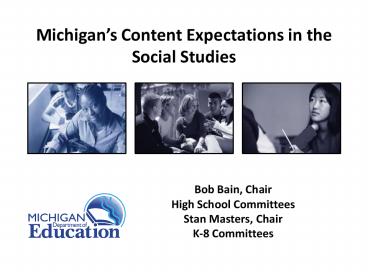Content Expectations - PowerPoint PPT Presentation
1 / 21
Title:
Content Expectations
Description:
J. Martin Rochester, Ph.D., University of Missouri - St. Louis, Civics and Government ... CIVICS AND GOVERNMENT. UNITED STATES HISTORY AND GEOGRAPHY. WORLD ... – PowerPoint PPT presentation
Number of Views:48
Avg rating:3.0/5.0
Title: Content Expectations
1
Michigans Content Expectations in the Social
Studies
Bob Bain, Chair High School Committees Stan
Masters, Chair K-8 Committees
2
Overview
- Bob Bain
- The K-12 Task
- The K-12 Challenges
- The K-12 Process
- The High School Expectations
- Some High School What ifs . . .
- Stan Masters
- Significant K-8 changes
- role of professional learning communities
- Role of authentic assessment and instruction
3
Five Questions Ill Consider
- What was our mission?
- What are the challenges in social studies?
- What was the process and feedback ?
- What are features in High School Content
Expectations? What should you keep in mind when
reviewing them? - What questions might we ask if .?
4
Background Our Mission ..
Our Mission
5
Enduring Challenges of Social Studies Standards
- Integrating separate disciplines
- Representing both disciplinary thinking and
substance - Providing an effective K-12 scope and sequence
- Managing Rigor and Reality Pedagogy and Politics
5
6
Curriculum Protocol Flowchart
Draft Documents Small Review Group MDE
representative practitioners
Document Development Work Group of Scholars Chair
and 5 8 appointed members OSI Convened
Final Documents Dissemination 3 Regional 10
Localized
Final Documents State Board Approval
7
Feedback from Reviews
- Too much Not enough . . .
- Majority currently in curriculum
- Integration of content too integrated
- Too specific not specific enough . . .
- You left out this event or this group.
7
8
National Review
- Ross E. Dunn, Ph.D., San Diego State University,
World History - Susan W. Hardwick, Ph.D., University of Oregon,
Geography - Gary B. Nash, Ph.D., UCLA, History
- J. Martin Rochester, Ph.D., University of
Missouri - St. Louis, Civics and Government - William Walstad, Ph.D., University of Nebraska,
Economics
9
High School ExpectationsThings to Look For
- Foundational Expectations
- Cross References
- Merger of Thinking and Substance
- Spatial Temporal Organizations in History and
Geography - Making embedded features more visible
9
10
National Review
- innovative cognitive and pedagogical approach to
studying the past at different scales of time and
space. Represents a large part of the answer to
the chronic problem in history and social studies
education of incoherence and fragmentation. -
Ross Dunn - the most innovative, imaginative, and up-to-date
state standards that I have seen.
Ross Dunn - have the potential to expand Michigan students
understanding of what it means to become active
and engaged learners and citizens.
Susan Hardwick
11
National Review
- . . .this is the most sophisticated and
carefully constructed framework yet to appear.
It should not only serve the teachers and
students of the State of Michigan well but stand
as a model for other states to follow.
Gary Nash - correctly recognizes the extensive prior
national work and includes a good description
and scheme of the NAEP framework William
Walstad - were certainly rigorous in the demands made on
students, solid in terms of clarity and
specificity.. Conscious efforts made to provide
coherence offers guidance that promises
first-rate social studies education in Michigan
schools. J. Marty Rochester
12
K-12 Revised to Provide
- a planned transition from elementary to middle
school and high school - a strong foundation for meeting the high school
content expectations - K-12 vertical alignment
- a system for referencing standards to other
sections, grades/courses, and to national
standards - increased transparency (NAEP, national standards)
13
Things to Remember
- Represents Content, Not Pedagogy
- Does Not Show Instructional Sequence
- Differentiation between required and suggested
content - Requires active, disciplined inquiry
- Guides instructional goals
14
Things I might be considering if I were a
- Classroom Teacher
- Department Chair
- District Supervisor
- Superintendent
15
Sequence of Study
Sequence of Study
16
K-5 Grade-Specific Context
- Kindergarten Myself and Others
- 1st Grade Families and Schools
- 2nd Grade The Local Community
- 3rd Grade Michigan Studies
- 4th Grade United States Studies
- 5th Grade Integrated United States History
17
6-8 Grade-Specific Context
- 6th Grade Western Hemisphere Studies
- 7th Grade Eastern Hemisphere Studies
- 8th Grade Integrated United States
History
18
Significant Changes
- Context for Grades 3 and 4
- World History in Grades 6 and 7
19
Professional Learning Communities
- Shared Norms and Values
- Focus on Student Learning
- Reflective Dialogue
- Public Practice
- Collaboration
20
Role of Authentic Assessment and Instruction
- Standards for Authentic Assessment Tasks
- Organization of Information
- Consideration of Alternatives
- Disciplinary Content
- Disciplinary Process
- Elaborated Communication
- Problem Connected to the World Beyond the
Classroom - Audience Beyond the Classroom
21
Role of Authentic Assessment and Instruction
- Standards for Authentic Instruction
- Higher Order thinking
- Deep Knowledge
- Substantive Conversation
- Connections to the World Beyond the Classroom































